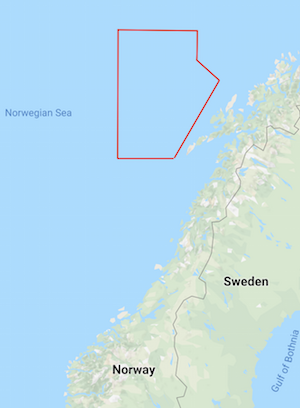Strikepods Complete IW Mission

The following is a work of speculative fiction, or FICINT (fiction intelligence).
Strikepods have engaged in the first unmanned undersea information operation conducted against an adversary, successfully generating a decoy submarine signature using both acoustic and magnetic emissions, and penetrating a Russian undersea network using advanced communication and cryptologic technologies.
The two-pronged undertaking, dubbed Operation Nøkken, after shapeshifting creatures featured in Scandinavian folklore, took place earlier this month in the Norwegian Sea during the annual NATO ASW training exercise Dynamic Mongoose.
-
During Dynamic Mongoose 2017, two uninvited guests in the form of Russian Akula-class submarines were detected operating just outside the exercise perimeter. Operation Nøkken was conceived with the assumption that Russian undersea surveillance would again occur during Dynamic Mongoose 2018, and as such could provide an ideal environment for validating newly developed undersea technologies.
-
Nøkken I would involve the deployment of a twelve-ship Strikepod comprised of Atom-class microsubmarines fitted with the Clandestine Access and Emission (CLAXEM) module. Upon detecting a Russian submarine, the Strikepod would utilize the CLAXEM technology to generate decoy emission signatures of a U.S. Los Angeles-class attack submarine.
-
Nøkken II would involve accessing Russian naval networks utilizing decoy communications and data transfers to test the viability of the module for covert SIGINT or offensive cyber operations.
Equipped with a powerful micro amplifier and magnetic field generator, the Clandestine Access and Emission (CLAXEM) module is capable of generating the acoustic and magnetic signatures of a range of adversary and allied submarines.
-
The combined CLAXEM emissions enable a single Strikepod to mimic the magnetic or acoustic signature of larger undersea craft.
-
Individually, the CLAXEM module can be used to mimic the acoustic or magnetic signatures of adversary or allied microsubmarines, including the Istina, Shāyú, Qom, Gwisin, Saaya, and Pasban.
The CLAXEM module is also equipped with Minuet, a suite of covert undersea communications technologies, including highly advanced signal processing and cryptologic technologies.
-
Minuet integrates with the Atom's onboard acoustic communications system to effectively transform it into an adversary network node.
-
Intelligence gathered during encounters with adversary micronaval assets has enabled the development of advanced algorithms capable of mimicking adversary undersea communications and data transmissions.
-
In addition to disrupting, intercepting, and spoofing adversary communications, Minuet enables the clandestine penetration of adversary undersea data networks for covert surveillance and/or deployment of offensive cyber weapons.

The approximate Dynamic Mongoose exercise area.
REPORT: Nokken I
In the early morning of 1 July, 2018, a Russian Akula-class submarine (GOBLIN) was detected approximately three kilometers north/northeast of the Dynamic Mongoose exercise perimeter. Shortly thereafter, ARCHER, a CLAXEM-equipped twelve-ship Strikepod, was dispatched to an area approximately five kilometers west of GOBLIN.
-
At 0530Z, ARCHER received the order, Execute: Chorus, at which time ARCHER assumed an elliptical formation and began broadcasting the acoustic signature of a Los Angeles-class submarine.
-
At 0540Z, GOBLIN turned toward ARCHER, making turns for 7 knots, and taking position 4 kilometers astern.
-
At 0605Z, ARCHER was ordered to turn northeast and proceed at 10 kts. At 0612Z, GOBLIN adjusted its heading to 045 and increased speed. At 0635Z, ARCHER was ordered to turn South at 5 kts. GOBLIN again altered her course to continue trailing ARCHER. GOBLIN proceeded to match ARCHER's course and speed for the next two hours.
-
At 0845Z, GOBLIN abruptly broke contact and rose to periscope depth. Shortly thereafter, shore-based SIGINT assets intercepted a coded transmission reporting undersea activity at ARCHER's location. At 0855Z, a Russian IL-38 maritime patrol aircraft (TERMITE) was scrambled from Severomorsk and vectored onto the last known location of ARCHER.
-
At 0910Z ARCHER was ordered to cease acoustic emissions and break formation in advance of TERMITE's arrival. GOBLIN continued searching an area at range 2.5 kilometers, depth 22 meters.
-
TERMITE arrived on station within the hour, assuming a patrol above what would have been the last known location of ARCHER. At 1115Z, ARCHER was ordered to an area approximately 1 kilometer northwest of TERMITE's patrol area, at a depth of 10 meters (Bullseye-1).
-
At 1135Z the order was given to Execute: Mosaic, at which time Archer assumed an elliptical formation and activated magnetic field generators.
-
At 1140Z, TERMITE broke from its patrol and vectored toward ARCHER's location, at which time ARCHER immediately ceased emissions and sprinted to Bullseye-2, approximately 1.5 kilometers north.
-
At 1141Z TERMITE arrived at BULLSEYE-1 and assumed patrol
-
At 1145Z, ARCHER once again executed Mosaic, this time at Bullseye-2.
-
At 1150Z, TERMITE broke from its patrol and vectored toward Bullseye-2
-
ARCHER immediately ceased emissions and sprinted to Bullseye-3, approximately 1 kilometer west of TERMITE and executed Mosaic once again. At 1155Z, TERMITE again vectored toward ARCHER's location. This cycle repeated two more times, at which point ARCHER was ordered to return to Bainbridge for recovery.
REPORT: Nøkken II
Phase II of Operation Nøkken began two days later with the detection of Istina-class microsubmarines launched from GOBLIN.
-
On July 3 at 1545Z, Strikepod BLACKJACK was deployed to patrol the northern edge of Dynamic Mongoose. At 1905Z, BLACKJACK detected six Istina-class microsubmarines breaching the exercise perimeter.
-
The Istinas proceeded toward the main body of the exercise, BLACKJACK turned and followed at a distance of approximately 750 meters, but did not engage or in any way provoke, to minimize risk of increased coms traffic with GOBLIN.
-
Once the Istinas were safely away, BLACKJACK was given the order to commence Nøkken II, at which time a single Atom - RUNABOUT - broke away from BLACKJACK and proceeded toward GOBLIN, running at only 2.5 km/h to minimize noise production. (Although there is still some question as to whether the Akula's MGK-540 Skat-3 (Shark Gill) sonar is sensitive enough to detect an Atom-class at close range, the presence of additional Istinas must be assumed.) Once the Atom arrived on station, it would stand by until the Istinas returned for recovery or data transmission.
-
At 2215, BLACKJACK detected three Istinas departing the exercise area, steaming toward the perimeter on a course toward GOBLIN.
-
At 2305Z, RUNABOUT detected the arrival of the Istinas.
-
At 2312 Istinas commenced data transfer, at which time RUNABOUT intercepted and parsed the stream, engaged crypto algorithms and analyzed the decrypted content, and proceeded to structure, compile, and transmit a dummy packet containing the mission code (STOWAWAY).
-
RUNABOUT remained on station, and at 0115 detected GOBLIN flooding her tubes, indicating she was preparing to recover the Istinas. At 0145 RUNABOUT departed the area, making slow turns at 2.5 kph until reaching the exercise perimeter.
-
At 0250Z, Bainbridge received a Bingo notification from BLACKJACK Relay-4, indicating that RUNABOUT had completed its mission and successfully rendezvoused with BLACKJACK. BLACKJACK proceeded to Bainbridge, where it was recovered for data exfiltration.
All mission objectives and CLAXEM performance objectives were met or exceeded expectations.
At this time we await further information concerning the deployment of STOWAWAY.
[End]
Strikepod Command

